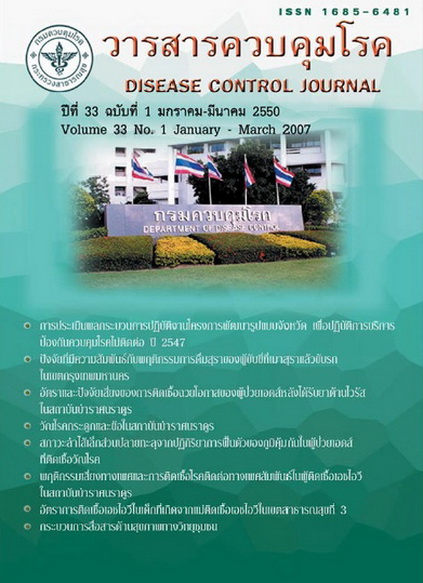Health Communication Process through Community Radio
Abstract
This qualitative research aimed at examining the health communication process through community radio and the factors affected health radio programs. The study had been conducted in four provinces, Ayutthaya, Rayong, Nakhon Ratchasima, and Uthai Thani where community radio stations was broadcasting health programs. Data were collected from two sample groups; radio programmers and local listeners. The radio programmers were purposive sampling from people who had been involving in community radio including community leaders, volunteers, health professionals, and other health agencies. Local listeners listening to health radio programs were chosen by accidental sampling. In-depth interview and focus group discussion techniques were employed in radio programmer groups while questionnaires were employed in local listener groups. The study found that community radio stations broadcasting in those provinces had employed a concept of communication process, which consisted of sender, message, channel, and receiver. The study revealed that most senders were knowledgeable about health information and has delivered key health messages to the listeners effectively. At the same time, most channels had not been interfered by any barriers. Health messages were also delivered in a timely manner. Concerning most receivers or local listeners, they were very satisfied with community radio that helped disseminate health messages rapidly so as to help them raise awareness of health risk and improve community health. The factors affected health radio programs were (1) insufficient funding health programs, (2) poor quality of broadcasting equipments, (3) shortage of radio programmers and (4) insufficient budget for logistics support. Therefore, to sustain health radio programs, sufficient funding health programs were recommended.
Downloads
References
2. เอื้อจิต วิโรจน์ไตรรัตน์. การสื่อสารในชุมชน.เอกสารโรเนียว, 2548.
3. กาญจนา แก้วเทพ. สื่อเพื่อชุมชน : การประมวลองค์ความรู้. กรุงเทพมหานคร : สำนักงานกองทุนสนับสนุนการวิจัย (สกว.), 2543.
4. กาญจนา แก้วเทพ. คู่มือวิทยุชุมชน. กรุงเทพมหานคร สำนักงานกองทุนสนับสนุน การวิจัย(สกว.) , 2546.
5. Roger M Everett & Ohemaker, F Floyd. Communicationof Innovations New York : The Free Freos, 1977.
6. เอื้อจิต วิโรจน์ไตรรัตน์. วิทยุกระจายเสียงเพื่อชุมชน. ศูนย์ประสานงานองค์กรประชาชนจังหวัดกาญจนบุรี. เอกสารโรเนียว, 2546.
7. ปรมะ สตะเวทิน. แนวคิดเกี่ยวกับการสื่อสารเพื่อการพัฒนา. เอกสารชุดวิชาการสื่อการพัฒนา.นนทบุรี: โรงพิมพ์มหาวิทยาลัยสุโขทัย ธรรมาธิราช, 2541.
Downloads
Published
How to Cite
Issue
Section
License
Articles published in the Disease Control Journal are considered as academic work, research or analysis of the personal opinion of the authors, not the opinion of the Thailand Department of Disease Control or editorial team. The authors must be responsible for their articles.






